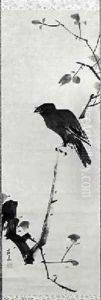Maruyama'Kyo Paintings
Maruyama Ōkyo, born Maruyama Masataka, was a significant Japanese artist known for his innovative approaches to painting and for founding the Maruyama school of Japanese painting. Born in 1733 in Ano, a region within the present-day city of Kyoto, Ōkyo came from humble beginnings. His early life was marked by hardship, and he initially trained as a carver of Buddhist images. However, his interest soon shifted towards painting, leading him to study under the accomplished Kano school artist Ishida Yūtei. Despite his traditional training, Ōkyo was deeply influenced by Western art, which was beginning to make its way into Japan through Nagasaki, the only Japanese port open to foreigners at the time.
Ōkyo's unique style combined the detailed realism found in Western art with the traditional themes and techniques of Japanese painting. He was particularly renowned for his mastery in depicting the natural world, with works that highlighted his keen observation and ability to render subjects with lifelike accuracy. His landscapes and images of flora and fauna were not only celebrated for their beauty but also for their ability to convey the transient beauty of nature, a concept deeply rooted in Japanese aesthetics.
In 1787, Maruyama Ōkyo founded the Maruyama school in Kyoto, which emphasized observational painting and the study of nature. This school became highly influential and spawned a new generation of painters who continued to blend Eastern and Western artistic traditions. Among his notable disciples were Matsumura Goshun and Nagasawa Rosetsu, who furthered the school's reputation and contributed to its legacy.
Ōkyo's impact on the development of Japanese painting was profound. His works, which include a wide range of subjects from the natural world to the supernatural, were innovative in their realism and technique, challenging the more stylized forms of painting that had dominated Japanese art for centuries. Throughout his career, he received numerous commissions from the imperial family and various feudal lords, solidifying his status as one of the era's leading artists.
Maruyama Ōkyo passed away in 1795, leaving behind a rich legacy that influenced not only the Maruyama school but also the subsequent development of nanga (literati painting) and Shijō school painting. His approach to art, characterized by a blend of Eastern and Western techniques and a deep reverence for nature, continues to be celebrated in Japanese art history.
